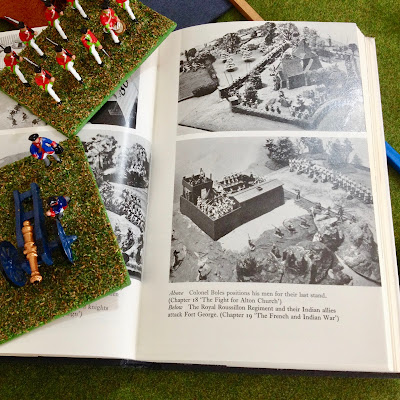It seems to have been quite a while since I last played a campaign. My most recent one was a 19th century mapless campaign. So it seemed about time to start another campaign and use my most recently completed French Indian war armies. In devising this new campaign I am looking to play about 6 to 10 games before the campaign ends.
My last map campaign was a Hundred Years War campaign using the map from the book "War Game Campaigns" by Donald Featherstone. It also contains a chapter for a French Indian War campaign, which was not so suited for the type of campaign I wanted, but never-the-less provided inspiration for the following campaign.
 |
| French Indian War Campaign Map |
The British have the objective of taking the fortified town top right of the map. They enter the map via one of the roads bottom left. Each side has their army is organised into separate forces, 5 for the defending French and 3 for the attacking British.
Forces move along roads, marked in dashes and brown, and on occasion can move along tracks with a guide or cross the river by boat for the British. The use of tracks and boats are limited and get ticked off once used.
Each side takes turns to move only one forces. A force may move from one area to another area via roads, tracks or boats. Two forces of the same side may never occupy the same area. There is no restriction as to which force is moved by a player during their turn. They may choose to only move one force if they wish and have the other forces hold position.
When two opposing forces end up in the same area, then a battle is fought. Both sides select 12 units and can add an additional 2 units if they choose to use one of their reinforcement options. These are limited and get ticked off when used.
Once a force is selected, using a deck of cards assigned a card to each unit and remove 4 units with the lowest cards. So the composition of a players force can vary from the original choice.
After the battle is fought the losing force must retire. If unable to retire, they surrender.









I do like your maps, they are so evocative, We should all campaign more.
ReplyDeleteThank you Norm. I do enjoy campaign games, particularly by mini-campaigns, as they seem to add something to the games.
DeleteI second both of Norm's comments. Your maps are wonderful.
ReplyDeleteThe WWII game also looks very enticing.
Thanks. The maps are sketched out in pencil and then felt-tipped pens used to provide colour.
DeleteVery nice and interesting map - just the thing for a limited campaign in a none-too-populous region. Don Feratherstone's campaign book I regard as one of THE classics of the genre.
ReplyDeleteThank you. The book has so many ideas for campaigning along with being an enjoyable read. I remember getting the book from the local library so many times.
DeleteLooking forward to another one of your campaigns. As those before mentioned, your map is first rate.
ReplyDeleteIs your WWII game in 15mm?
Thanks. The WWII game is 20mm, a combination of Airfix for nostalgia reasons and ArmourFast models (really like these models).
DeleteA Very Neat Table Top for Games.
ReplyDeleteI Like The Maps and Model Soldiers Too.
Greetings From the Evergreen Gardens of Fiddle Wood UK. BB
Greetings and thank you kindly.
Delete